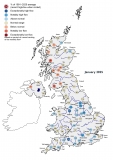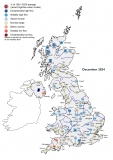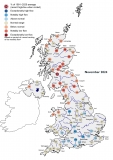Submitted by Katie Muchan on
July was an unsettled month and was very wet in some areas, particularly in southern England. The July mean temperature for the UK as a whole was near average, but it was moderately warmer in the south-east and cooler in the north-west. Some hot spells triggered thundery downpours, with associated flash flooding, including the most severe flash flood in a coastal catchment in south-west England since the Boscastle floods of August 2004. For the UK as a whole, the summer of 2017 has been exceptionally wet so far, adding to a cluster of wet June-July rainfall totals in the last decade (including 2007 and 2012, both significantly wetter than 2017; these three totals are in the top five in a record from 1910). As with these other recent summers, the wet spell has effected a transformation in the national-scale hydrological situation, albeit much less dramatically than in 2012. Long-term rainfall deficiencies have been moderated in much of the country, and above average July river flows were prevalent in northern and western Britain; correspondingly, end-of-July reservoir stocks were near-average nationally. However, the imprint of the dry winter and spring is still apparent: below average stocks persisted in some reservoirs in southern and central Britain (with >15% below for Elan Valley, Wimbleball and Bewl) and river flows remained below normal in some catchments. Similarly, July groundwater levels were notably low across much of the Chalk. While the July rainfall could have a delayed influence on late summer groundwater levels, it is increasingly likely that the autumn recharge season will begin from a below normal baseline in parts of the south, with potential implications for the longer-term water resources situation.



